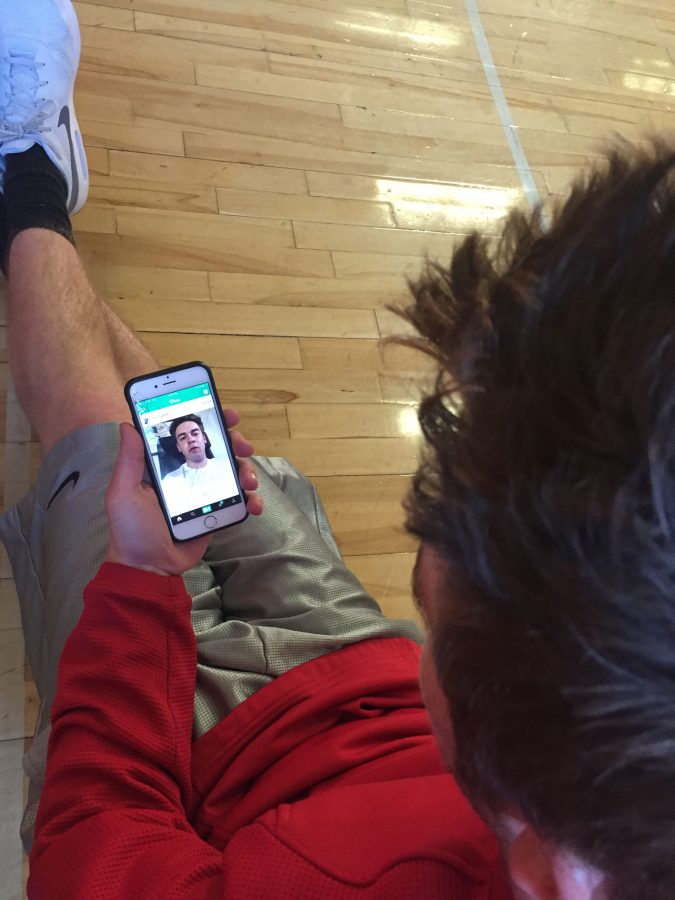#RIPVine
Senior Ryan Magee uses Vine, as the app is still accessible, but no new content can be posted.
January 12, 2017
On Jan. 23, 2013, a new app was released. It was known as Vine, an app that allowed users to create six-second GIFs for all of their family and friends to see. This app exploded with downloads later in 2013 when the app was upgraded to allow people to use front-facing camera support as well. It became the new up-and-coming app.
“I liked Vine because I thought the concept of a six second video to make you dying of laughter was so awesome,” said Kelli Cigelnik, senior.
Vine allowed users to create a video– anytime and anywhere– of anything they wanted. Many users saw this as an opportunity, and people became famous– some for just a short period of time and others for a longer period of time because of their humor or talent.
Users, such as KingBach, Lele Pons and Brittany Furlan, have been Vine famous since the app was launched. They practically became celebrities and gained further opportunities that would allow them to keep their fame going.
But what died was the app itself.
“I think Vine is dying down just because people like new things, and people get bored more easily, kind of like when Facebook started to die down,” Cigelnik explained.
Vine has come across competitors like Instagram, YouTube and Snapchat. These apps challenged Vine because they had similar features as Vine, and even some had better features, too. With Snapchat, users could make videos as long as 10 seconds and send them to certain people. Instagram first came out with an upgrade right after Vine came out that allowed people to make 15 second videos, but now they even changed it to allow people to create a video up to a minute long.
YouTube, though, is where most of these Viners turned to after they started getting more and more famous. People wanted to see more than just a six-second video of them.
“Vine isn’t special anymore because it got blown up by more popular Viners who are now actors, and when I was younger, they were just Viners making stupid Vines, and now they are all famous and taken over by the media,” said Cigelnik.
These Viners are no longer Viners, then; they are now YouTubers, using Vine to brand their channels.
“It was special when people made Vines to make people laugh and not to sell products,” said Senior Will Michalski.
This shift in use is what many think made Vine lose its users. People wouldn’t see Vines that made them laugh or feel good. All they would see was their old favorite Viners trying to sell products on it.
Also, these famous Viners changed the way Vines were being made.
“Now they are using movie-esque production styles to make them,” said Michalski.
They also just snip and clip their Youtube videos and make them into short videos, so they can post them on Vine.
Many users didn’t like how their favorite Viners started doing this. They missed the old humor that they had and didn’t want to see more branding videos about products or other apps they could find these “Viners” on.
This decreased downloads and views on Vine, forcing the app’s company to make some hard decisions.
Twitter owns Vine, and the CEO Jack Dorsey announced on Oct. 20 that they would be shutting down Vine but would give users enough notice in order to download Vines that had been created in the past.
Twitter stated in a press release, “We value you, your Vines, and are going to do this the right way. You’ll be able to access and download your Vines. We’ll be keeping the website online because we think it’s important to still be able to watch all the incredible Vines that have been made. You will be notified before we make any changes to the app or website.”
Vine rose and fell over the course of four years, from 2012 to 2016.
| June 17, 2012 | Rus Yusupov and Dom Hofmann create Vine. |
| Oct. 9, 2012 | Vine is about to be released until Twitter buys Vine for $30 million, so they can work on the app and release it when they think it’s ready. |
| Jan. 23, 2013 | Vine is released on IOS for the iPhone and iPod. |
| April 2013 | Vine is the most downloaded app on the Apple store in the U.S. |
| June 3, 2013 | Vine is released for the Android. |
| August 2013 | Vine has 40 million users. |
| 2013 | Active teen users grow by an astounding 639 percent! |
| May 1, 2014 | Vine’s web version of service is launched. |
| July 19, 2014 | User Lele Pons is the first Viner to reach one billion loops. |
| 2015 | Vine reaches 1.5 billion loops a day. |
| January 2015 | Twitter starts paying less for Vine, which affects its success. |
| September & November 2015 | Vine only receives 4 percent of branded content videos, beaten by Instagram, Facebook and YouTube. |
| November 24, 2015 | Vine creates an update; when browsing in a channel or through one’s own feed, simply swipe left on a Vine to see other content that is similar to the previous Vine. |
| October 20, 2016 | The CEO Jack Dorsey announces that Vine will be shutting down. |



